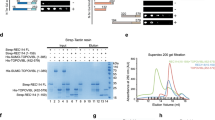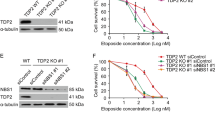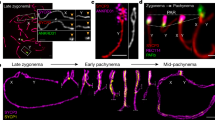Abstract
In many organisms, developmentally programmed double-strand breaks (DSBs) formed by the SPO11 transesterase initiate meiotic recombination, which promotes pairing and segregation of homologous chromosomes1. Because every chromosome must receive a minimum number of DSBs, attention has focused on factors that support DSB formation2. However, improperly repaired DSBs can cause meiotic arrest or mutation3,4; thus, having too many DSBs is probably as deleterious as having too few. Only a small fraction of SPO11 protein ever makes a DSB in yeast or mouse5 and SPO11 and its accessory factors remain abundant long after most DSB formation ceases1, implying the existence of mechanisms that restrain SPO11 activity to limit DSB numbers. Here we report that the number of meiotic DSBs in mouse is controlled by ATM, a kinase activated by DNA damage to trigger checkpoint signalling and promote DSB repair. Levels of SPO11–oligonucleotide complexes, by-products of meiotic DSB formation, are elevated at least tenfold in spermatocytes lacking ATM. Moreover, Atm mutation renders SPO11–oligonucleotide levels sensitive to genetic manipulations that modulate SPO11 protein levels. We propose that ATM restrains SPO11 via a negative feedback loop in which kinase activation by DSBs suppresses further DSB formation. Our findings explain previously puzzling phenotypes of Atm-null mice and provide a molecular basis for the gonadal dysgenesis observed in ataxia telangiectasia, the human syndrome caused by ATM deficiency.
This is a preview of subscription content, access via your institution
Access options
Subscribe to this journal
Receive 51 print issues and online access
$199.00 per year
only $3.90 per issue
Buy this article
- Purchase on Springer Link
- Instant access to full article PDF
Prices may be subject to local taxes which are calculated during checkout




Similar content being viewed by others
References
Keeney, S. in Recombination and Meiosis: Crossing-Over and Disjunction Vol. 2 (ed. Lankenau, D. H. ) 81–123 (Springer, 2007)
Cole, F., Keeney, S. & Jasin, M. Evolutionary conservation of meiotic DSB proteins: more than just Spo11. Genes Dev. 24, 1201–1207 (2010)
Sasaki, M., Lange, J. & Keeney, S. Genome destabilization by homologous recombination in the germ line. Nature Rev. Mol. Cell Biol. 11, 182–195 (2010)
Hochwagen, A. & Amon, A. Checking your breaks: surveillance mechanisms of meiotic recombination. Curr. Biol. 16, R217–R228 (2006)
Neale, M. J., Pan, J. & Keeney, S. Endonucleolytic processing of covalent protein-linked DNA double-strand breaks. Nature 436, 1053–1057 (2005)
Pan, J. et al. A hierarchical combination of factors shapes the genome-wide topography of yeast meiotic recombination initiation. Cell 144, 719–731 (2011)
Daniel, K. et al. Meiotic homologue alignment and its quality surveillance are controlled by mouse HORMAD1. Nature Cell Biol. 13, 599–610 (2011)
Barlow, C. et al. Atm-deficient mice: a paradigm of ataxia telangiectasia. Cell 86, 159–171 (1996)
Xu, Y. et al. Targeted disruption of ATM leads to growth retardation, chromosomal fragmentation during meiosis, immune defects, and thymic lymphoma. Genes Dev. 10, 2411–2422 (1996)
Barlow, C. et al. Atm deficiency results in severe meiotic disruption as early as leptonema of prophase I. Development 125, 4007–4017 (1998)
Di Giacomo, M. et al. Distinct DNA-damage-dependent and -independent responses drive the loss of oocytes in recombination-defective mouse mutants. Proc. Natl Acad. Sci. USA 102, 737–742 (2005)
Barchi, M. et al. Surveillance of different recombination defects in mouse spermatocytes yields distinct responses despite elimination at an identical developmental stage. Mol. Cell. Biol. 25, 7203–7215 (2005)
Bellani, M. A., Romanienko, P. J., Cairatti, D. A. & Camerini-Otero, R. D. SPO11 is required for sex-body formation, and Spo11 heterozygosity rescues the prophase arrest of Atm−/− spermatocytes. J. Cell Sci. 118, 3233–3245 (2005)
Barchi, M. et al. ATM promotes the obligate XY crossover and both crossover control and chromosome axis integrity on autosomes. PLoS Genet. 4, e1000076 (2008)
Keeney, S. et al. A mouse homolog of the Saccharomyces cerevisiae meiotic recombination DNA transesterase Spo11p. Genomics 61, 170–182 (1999)
Shannon, M., Richardson, L., Christian, A., Handel, M. A. & Thelen, M. P. Differential gene expression of mammalian SPO11/TOP6A homologs during meiosis. FEBS Lett. 462, 329–334 (1999)
Bellani, M. A., Boateng, K. A., McLeod, D. & Camerini-Otero, R. D. The expression profile of the major mouse SPO11 isoforms indicates that SPO11β introduces double strand breaks and suggests that SPO11α has an additional role in prophase in both spermatocytes and oocytes. Mol. Cell. Biol. 30, 4391–4403 (2010)
Kauppi, L. et al. Distinct properties of the XY pseudoautosomal region crucial for male meiosis. Science 331, 916–920 (2011)
Romanienko, P. J. & Camerini-Otero, R. D. Cloning, characterization, and localization of mouse and human SPO11. Genomics 61, 156–169 (1999)
Romanienko, P. J. & Camerini-Otero, R. D. The mouse Spo11 gene is required for meiotic chromosome synapsis. Mol. Cell 6, 975–987 (2000)
Bellve, A. R. et al. Spermatogenic cells of the prepuberal mouse. Isolation and morphological characterization. J. Cell Biol. 74, 68–85 (1977)
Eaker, S., Cobb, J., Pyle, A. & Handel, M. A. Meiotic prophase abnormalities and metaphase cell death in MLH1-deficient mouse spermatocytes: insights into regulation of spermatogenic progress. Dev. Biol. 249, 85–95 (2002)
Terasawa, M., Ogawa, T., Tsukamoto, Y. & Ogawa, H. Sae2p phosphorylation is crucial for cooperation with Mre11p for resection of DNA double-strand break ends during meiotic recombination in Saccharomyces cerevisiae. Genes Genet. Syst. 83, 209–217 (2008)
Sasanuma, H. et al. Cdc7-dependent phosphorylation of Mer2 facilitates initiation of yeast meiotic recombination. Genes Dev. 22, 398–410 (2008)
Mahadevaiah, S. K. et al. Recombinational DNA double-strand breaks in mice precede synapsis. Nature Genet. 27, 271–276 (2001)
Sedgwick, R. P. & Boder, E. in Handbook of Clinical Neurology Vol. 16 (ed. de Jong, J. M. B. V. ) 347–423 (Elsevier, 1991)
Savitsky, K. et al. A single ataxia telangiectasia gene with a product similar to PI-3 kinase. Science 268, 1749–1753 (1995)
Edelmann, W. et al. Meiotic pachytene arrest in MLH1-deficient mice. Cell 85, 1125–1134 (1996)
Pittman, D. L. et al. Meiotic prophase arrest with failure of chromosome synapsis in mice deficient for Dmc1, a germline-specific RecA homolog. Mol. Cell 1, 697–705 (1998)
Baudat, F., Manova, K., Yuen, J. P., Jasin, M. & Keeney, S. Chromosome synapsis defects and sexually dimorphic meiotic progression in mice lacking Spo11. Mol. Cell 6, 989–998 (2000)
Acknowledgements
We thank M. Neale for discussions, R. Cha and K. McKim for sharing data before publication, and M. Hwang for assistance in monoclonal antibody development. This work was supported by NIH grants HD040916 and HD053855 (to M.J. and S.K.) and GM058673 (to S.K.). J.P. was supported in part by a Leukemia and Lymphoma Society Fellowship and F.C. by a Ruth L. Kirschstein NRSA (F32 HD51392). S.K. is an Investigator of the Howard Hughes Medical Institute.
Author information
Authors and Affiliations
Contributions
J.L., J.P. and F.C. performed experiments. M.P.T. generated the anti-SPO11 monoclonal hybridoma line. J.L., M.J., and S.K. wrote the paper.
Corresponding authors
Ethics declarations
Competing interests
The authors declare no competing financial interests.
Supplementary information
Supplementary Figure
The file contains Supplementary Figure 1 with a legend. (PDF 401 kb)
Rights and permissions
About this article
Cite this article
Lange, J., Pan, J., Cole, F. et al. ATM controls meiotic double-strand-break formation. Nature 479, 237–240 (2011). https://doi.org/10.1038/nature10508
Received:
Accepted:
Published:
Issue Date:
DOI: https://doi.org/10.1038/nature10508
This article is cited by
-
RAD51 is essential for spermatogenesis and male fertility in mice
Cell Death Discovery (2022)
-
The genome loading model for the origin and maintenance of sex in eukaryotes
Biologia Futura (2022)
-
Mating type specific transcriptomic response to sex inducing pheromone in the pennate diatom Seminavis robusta
The ISME Journal (2021)
-
HIGH CROSSOVER RATE1 encodes PROTEIN PHOSPHATASE X1 and restricts meiotic crossovers in Arabidopsis
Nature Plants (2021)
-
Concerted cutting by Spo11 illuminates meiotic DNA break mechanics
Nature (2021)
Comments
By submitting a comment you agree to abide by our Terms and Community Guidelines. If you find something abusive or that does not comply with our terms or guidelines please flag it as inappropriate.



